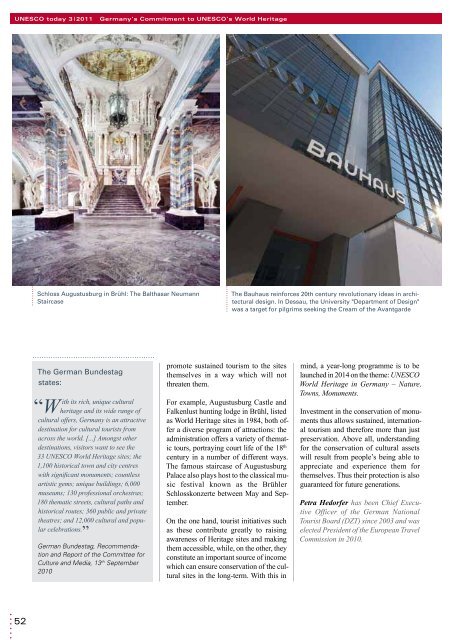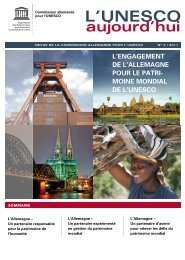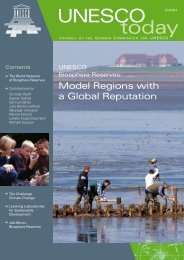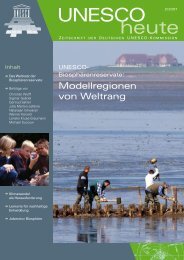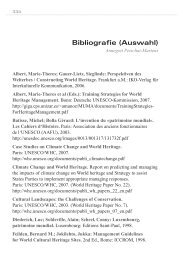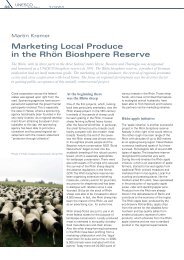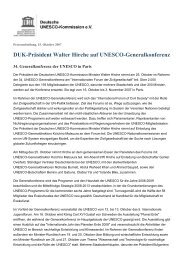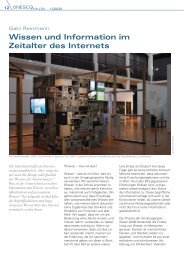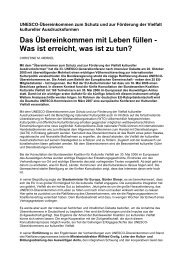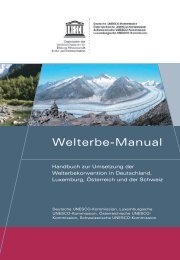Download - UNESCO Deutschland
Download - UNESCO Deutschland
Download - UNESCO Deutschland
Create successful ePaper yourself
Turn your PDF publications into a flip-book with our unique Google optimized e-Paper software.
UNesCO today 3 | 2011 germany’s Commitment to UNesCO’s World Heritage<br />
52<br />
Schloss Augustusburg in Brühl: The Balthasar Neumann<br />
Staircase<br />
The German Bundestag<br />
states:<br />
“W<br />
ith its rich, unique cultural<br />
heritage and its wide range of<br />
cultural offers, Germany is an attractive<br />
destination for cultural tourists from<br />
across the world. [...] Amongst other<br />
destinations, visitors want to see the<br />
33 <strong>UNESCO</strong> World Heritage sites; the<br />
1,100 historical town and city centres<br />
with significant monuments; countless<br />
artistic gems; unique buildings; 6,000<br />
museums; 130 professional orchestras;<br />
180 thematic streets, cultural paths and<br />
historical routes; 360 public and private<br />
theatres; and 12,000 cultural and popular<br />
celebrations. ˮ<br />
German Bundestag, Recommendation<br />
and Report of the Committee for<br />
Culture and Media, 13 th September<br />
2010<br />
promote sustained tourism to the sites<br />
themselves in a way which will not<br />
threaten them.<br />
For example, Augustusburg Castle and<br />
Falkenlust hunting lodge in Brühl, listed<br />
as World Heritage sites in 1984, both offer<br />
a diverse program of attractions: the<br />
administration offers a variety of thematic<br />
tours, portraying court life of the 18 th<br />
century in a number of different ways.<br />
The famous staircase of Augustusburg<br />
Palace also plays host to the classical music<br />
festival known as the Brühler<br />
Schlosskonzerte between May and September.<br />
On the one hand, tourist initiatives such<br />
as these contribute greatly to raising<br />
awareness of Heritage sites and making<br />
them accessible, while, on the other, they<br />
constitute an important source of income<br />
which can ensure conservation of the cultural<br />
sites in the long-term. With this in<br />
The Bauhaus reinforces 20th century revolutionary ideas in architectural<br />
design. In Dessau, the University "Department of Design"<br />
was a target for pilgrims seeking the Cream of the Avantgarde<br />
mind, a year-long programme is to be<br />
launched in 2014 on the theme: <strong>UNESCO</strong><br />
World Heritage in Germany – Nature,<br />
Towns, Monuments.<br />
Investment in the conservation of monuments<br />
thus allows sustained, international<br />
tourism and therefore more than just<br />
preservation. Above all, understanding<br />
for the conservation of cultural assets<br />
will result from people’s being able to<br />
appreciate and experience them for<br />
themselves. Thus their protection is also<br />
guaranteed for future generations.<br />
Petra Hedorfer has been Chief Executive<br />
Officer of the German National<br />
Tourist Board (DZT) since 2003 and was<br />
elected President of the European Travel<br />
Commission in 2010.


